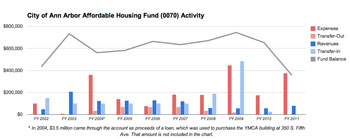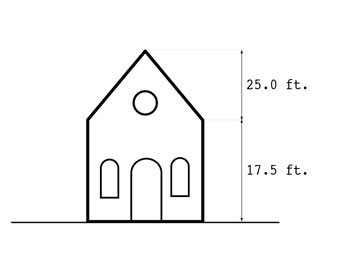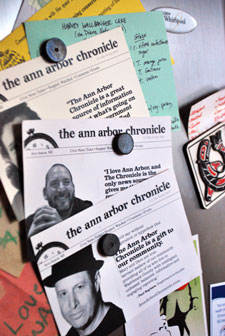In the coming weeks, the Ann Arbor city council will be taking up discussion of a policy that was changed a half-decade ago – as part of a land sale by the city.

Affordable housing fund activity from 2002-2011, based on data in the city of Ann Arbor’s Comprehensive Annual Financial Reports from those years. Red bars are expenditures and blue bars are revenues. The gray line is the fund balance. Image links to higher resolution file.
A June 4, 2007 city council action authorized the sale of city-owned property on East Eisenhower for $23,750. But the council’s action that summer also included a “resolved” clause that rescinded the city’s policy dealing with the proceeds from the sale of city-owned land. As a result of that “resolved” clause, proceeds from the sale of city-owned land were no longer required to be deposited into the city’s affordable housing trust fund.
The city council will soon be reviewing that policy, with this possible outcome: It could again become official city policy that the proceeds from sales of city-owned land will be designated at least in part to support affordable housing.
Leah Gunn, chair of the Ann Arbor Downtown Development Authority board, conveyed news of the upcoming policy discussion to her colleagues at an Aug. 29 meeting of the DDA’s operations committee. But it’s Sandi Smith – a city councilmember representing Ward 1 and a DDA board member – who is leading the effort to reconsider the land-sale-proceeds policy. She emailed her colleagues on the city council earlier in the week alerting them of her intention to revisit the issue – with an action item to come at the council’s Sept. 17 meeting.
Gunn will be seeking support from the rest of the DDA board, encouraging the city council to revert to the previous policy in some form – so that proceeds from the sale of city-owned land are designated to support affordable housing. That resolution of support will be on the DDA board’s Sept. 5 meeting agenda. Gunn also indicated that she’d ask her colleagues on the Washtenaw County board of commissioners to pass a resolution of support for the city council to change the policy. The county board’s next meeting is also on Sept. 5.
Any change in the current policy will come in the context of the DDA’s current planning effort, called Connecting William Street, for five city-owned parcels in downtown Ann Arbor, some of which could eventually be sold.
The upcoming council discussion, focusing just on this policy, will take place five years later than Ward 3 city councilmember Stephen Kunselman had wanted. On June 4, 2007 Kunselman had objected to including the policy shift as one of many “resolved” clauses in a land transaction resolution, saying that it wasn’t consistent with transparent governance.
The motivation for the change in policy back in 2007 involved a desire to put the $3 million in proceeds from selling the First and Washington parcel toward the building fund of a new police/courts building (now officially dubbed the Justice Center). The property was sold to Village Green, which is currently constructing City Apartments, with 156 residential units and a 244-space parking structure on the bottom two floors. The parcel was previously the site of a 199-space parking structure. Of the 156 units in the City Apartments project, 16 are supposed to be affordable to those earning between 60-80% of the area median income (AMI) – a requirement of the project’s planned unit development (PUD) zoning.
Provision of “affordable” housing within a project like City Apartments is one of at least two different strategies used by the city to address the need for a diversity of affordable housing options. Another strategy is for a developer to make a payment in lieu of providing the units themselves – a payment that is deposited into the affordable housing trust fund. The idea behind that strategy is that affordable units might be constructed more economically elsewhere, using money from the trust fund.
While downtown Ann Arbor is in some ways an ideal location for affordable housing – because it’s easier to provide supportive human services to those residents who need them – the cost of real estate in the downtown area is higher than elsewhere in Washtenaw County. That’s a secondary piece of the policy discussion that the city council will likely have about the land-sale-proceeds policy.
In a phone interview with Mary Jo Callan, head of the city/county office of community and economic development, she described how one of her first tasks since taking the position in 2007 was to find strategies for replacing the 100 units of single resident occupancy supportive housing in the former YMCA. Those units had been lost when the building – owned by the city at that time – was condemned and subsequently demolished. Since the city’s affordable housing trust fund’s inception, Callan said the fund has invested in 399 units of affordable housing.
A look back to the city council meeting on June 4, 2007 shows that local government today still deals with many of the same topics – dog parks, affordable housing, transparency. Although the origin of the land-sale-proceeds policy and its connection to affordable housing goes back even further, to 1996, we’ll begin this report with the June 2007 action. [Full Story]








